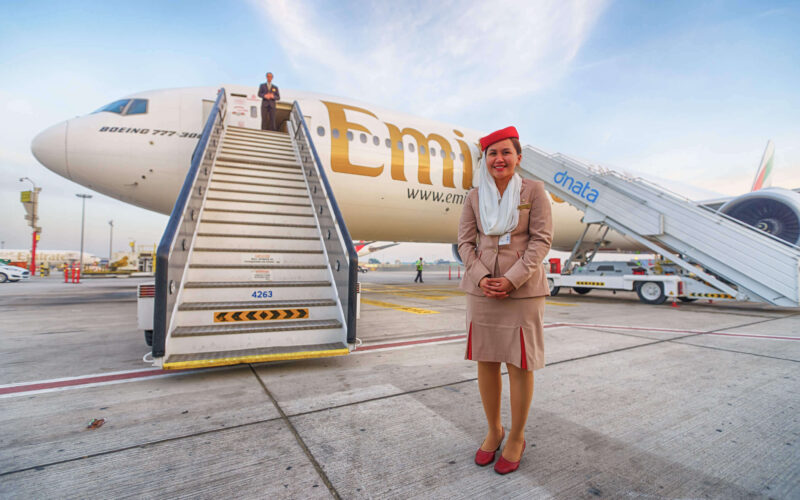This article was first published on October 3, 2019.
The Airbus A380 (ex-)lifeline supplier and flagship operator as well as the largest Boeing 777 operator in the world, Emirates keeps it simple when it comes to their fleet: they pick large planes and stick to them. But how the Gulf carrier’s fleet will look like in a decade once the superjumbos begin going out of service?
In Emirates World Interview podcast, Tim Clark, the CEO of the airline, has revealed how the Emirates fleet might look like at the end of the next decade. Currently flying only two types of aircraft – Boeing 777 and Airbus A380 – the fleet will likely be more diverse and far bigger by the end of 20s and early 30s.
According to Clark, at one end of the scale it will still have 500+ seating superjumbos, while on another there will be the “smaller twins”. “Smaller”, of course, in Emirates standards as the “twins” are A330neo, A350XWB and Boeing 787-9, -10 pairs, all of which seat 280+ passengers.
In particular, the 787-9 seats 280, while the 787-10 seats 290 to 310 passengers. In turn, A330-900 seats 310 passengers, while A350-900 accommodates between 300 and 350 passengers.
Emirates and the Boeing 777(X)
Of the 268 aircraft that Emirates currently flies, according to planespotters.net data, the majority of them ‒ 155 ‒ are Boeing 777s. In 10-15 years, the aircraft will likely still hold a considerable place in the fleet.
Emirates will be one of the first airlines to take the brand new “folding wing” Boeing 777X. The airline firmed up its order for the type back in 2014 and now expects to welcome the first of its 150 777Xs in 2020. At least, it hopes to. Tim Clark, Emirates CEO, said in the podcast that the aircraft are “contracted to come to us in June 2020”.
Knowing Emirates’ disappointment with reliability of aircraft and engines manufacturers and Boeing’s troubles with 777X development, Clark’s given timeline of 777X service entry does not sound too confident.
In September 2019, the CEO told reporters that the airline would not take delivery of new Airbus and Boeing jets unless the plane makers and engine manufacturers – Rolls-Royce, General Electric – got their act together.
The engine manufacturer’s problems are indeed threatening the 777X entry into service. The wide-body is to be powered by GE9X engine, which is currently under development. In June 2019, GE Aviation revealed that an issue with its component was detected during testing. Consequently, that meant that engine certification was unlikely to take place until autumn 2019, meaning that the maiden flight of the 777X was delayed by “several months”.
Delayed or not, in ten years 777Xs will be part of Emirates fleet. “You’ll see the fleet of 777Xs” Clark said, also adding that the airline plans to operate both two types of the new triple seven: the -8 and -9.
The airline has been a faithful customer of the Boeing triple seven since 1992, Boeing order book indicates, when it placed its first, shy order for six 777-200ERs. Since then, Emirates’ 777 fleet has grown to be the biggest in the world, and planes in its orders are now counted in the hundreds.
What will step into A380 shoes?
While Boeing 777s are here to stay, the same cannot be said about Emirates’ beloved Airbus A380. With 110 superjumbos in its fleet, the carrier is still awaiting 13 more to be delivered before Airbus ceases its production in 2021. Which means that in the next ten years Emirates will no longer be receiving new A380s and will be retiring some instead.
“As far as Emirates is concerned, these aircraft will be flying until mid-30s, so there is a long time to go before the aircraft disappears from Emirates fleet,” Clark said. He, however, admitted that by the turn of the third decade (2030s) Emirates will be flying a “residual A380 fleet” of some 80-90 aircraft.
Since no other aircraft currently can compete with the superjumbo in capacity (in terms of passenger seats), this means that Emirates will turn to smaller aircraft. In February 2019, Emirates announced an order for 40 A330-900s (deliveries to start from 2021) and 30 A350-900s (deliveries to start from 2024). The order appears to be not finalized yet, as Airbus does not list in it is official order book.
Besides the A330neo and A350XWB, Emirates “continue to be looking” at the Boeing 787, Clark said. Of the three Dreamliner versions currently flying, the Gulf airline is considering two options: the -9 and -10.

